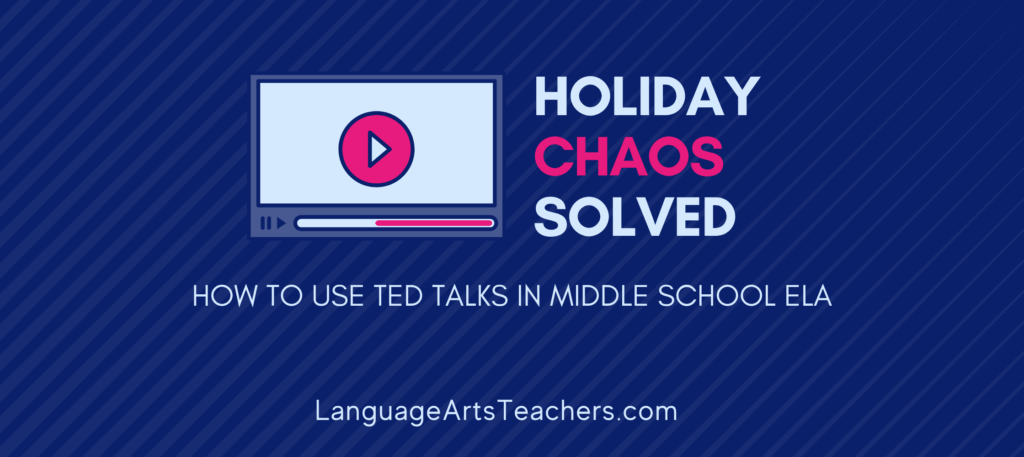With neverending to-do lists, it’s overwhelming to think about how to incorporate social-emotional learning (SEL) into our classrooms. With so many mounting responsibilities, how can we possibly begin to tackle the countless needs of our students?
We realize this is a big job. Like, a really big job.
However, we also recognize that promoting SEL can have lasting positive effects, including improved academic outcomes. This not only positively impacts our students, but it supports the adults that work exhaustingly hard each day to make a difference for kids.
This is exactly what I sat down to talk about (and later write about below) with guest expert Britney Dent of https://www.bestchoicecoach.com/. If you missed our conversation during the MSELA Summit (the virtual conference for Middle School ELA Teachers), then click here to check out all the topics, SEL included).
Britney and I dove into the five parts of Social Emotional Learning, three ways to implement SEL in our classrooms, and even how to use an SEL approach when communicating with our students’ parents!
Here’s what we learned from the MSELA Summit conversation with Best Choice Coach Britney Dent:
The Five Components of Social Emotional Learning (SEL)
In order to promote social and emotional well-being, we first need to understand the components that make up SEL. If a student is struggling in your classroom, you may want to consider which of these areas needs additional support.
- Self-awareness is the first step in promoting SEL. According to the JED Foundation, self-awareness is the ability to understand and recognize emotions in yourself. Students are often left to ponder who they are, what they care about, and how they fit in the world. These are some big topics for underdeveloped minds to contemplate! Our role as teachers is to support and help students develop an understanding of who they are.
- Self-management is the ability to regulate and manage one’s emotions. How can we teach self-management? We model it. It is vital to remember that students may not have healthy models at home. We may be the only adult that has ever demonstrated how to cope with big feelings. We can either spend time teaching students how to manage their emotions, or we can spend time redirecting problematic behavior. Either way, we spend the time.
- Social-awareness evolves from the student’s ability to recognize emotions in themselves to the awareness of other individuals’ emotions and experiences. While this has always been a challenging skill to teach, the COVID-19 pandemic has exacerbated an already difficult task. Missed opportunities for social interaction, in addition to masking, has complicated our current generation of students’ ability to relate to others.
- Relationship-skills include a student’s ability to communicate. Students tend to do generally well with friends or teachers that they like or prefer. However, how do students interact with those they dislike? How do they adjust their behavior when communicating with friends, teachers, or parents? While these skills are complex, we can assist by coaching our students through hypothetical or real-life scenarios; developing their social toolbox, bit by bit.
- Decision-making is perhaps the most challenging of the five components to address. When we think about decisions that our students have made, we may cringe and say, “What were they thinking?” But in all seriousness, these are teachable moments. According to the Child Mind Institute, we can help promote positive decision-making in our students by, ironically, letting them make bad decisions. Once they’ve experienced a consequence, we can step in to help them review. When we weigh-in and walk through situations with students, we can support their decision-making confidence in the future.
Three Easy Ways to Implement SEL
How can we make small adjustments within our classrooms to meaningfully incorporate SEL? Good news. It’s a lot easier than you may think. With a few changes, we can transform our classrooms into positive, brain-developing powerhouses.
Here are some small ways you can implement SEL starting today:
- A brain break is a short, intentional pause in classroom instruction to help students reset and refocus to productively return to learning. While you’ve likely incorporated this before, we ask that you shift your thinking a bit. Instead of primarily using a brain break as a time to reset, what if we used this time to affirm our students of their capabilities? When we tell students that they are leaders, problem-solvers, and change-makers, they just might begin to believe it themselves.
- Seating charts can provide a necessary change for a teacher struggling with chatty middle schoolers. However, we suggest making one small change. Ask for student input. When we ask students, we gain incredibly valuable data. By discovering who they want to sit by, we can identify who they don’t want to sit by. This can help us pinpoint students that may be missing key support. Perhaps we subtly provide that student some valuable relational skill-building, or maybe we seat them next to a positive peer-model. Regardless, don’t leave something as simple as a seating chart up to chance. The connections we help create can truly transform a student’s school experience.
- Music is an undervalued tool in the classroom. Just as music sets the tone for any movie scene, it can also set the tone in your space. Create the environment that you want to elicit from your students. If you have a loud and energetic bunch, you may need to incorporate calming music and dimmed lights. If you need to energize a tired crew, try something fun and upbeat to start their day. Better yet, give them some control in the decision when appropriate. Choice in the classroom can be one of the more motivating influencers of student learning. Discovering what your students like, and in turn valuing their likes and dislikes, speaks volumes to your influence as a teacher.
Leveraging Parent Relationships in Supporting Students
We can make meaningful changes in our classroom spaces and in our own practice as educators, but without familial support, we know it might not be enough.
When families are engaged in their child’s education, students are more successful and the entire community benefits.
While we can’t control for all factors, here are a few strategies:
- Identify early in the school year how parents prefer to be communicated with. For some families, emails get missed and voicemails go unanswered. Therefore, some may prefer text. By showing parents that you respect their preferred communication choice, we can spend less time trying to contact parents and more time connecting with parents. You can use apps such as ClassDojo, Remind, or Google Voice for privacy.
- Connect with parents early and often. By setting the tone early in the school year, parents develop an understanding that they are a partner in their child’s education and their opinions matter. Some schools provide prepaid postcards for teachers to introduce themselves to students and families. This can be a small but effective strategy for making a positive first connection.
- Make contacts proactively instead of reactively. When parents see the school on their caller ID, they may assume that their child is either ill or in trouble. Imagine their pleasant surprise when you call to share what a great job their child did on their presentation or how kind they were to a friend. Providing proactive feedback helps families have positive interactions with their school community.
- Provide explicit information on all of the ‘ins and outs.’ We cannot assume that anything is obvious for families. What seems simple or straightforward to us may not be for a parent/guardian. Truthfully, parents don’t always know what to do, or how to do it when it comes to their child’s education. Provide a framework whenever possible.
- Offer in-person and virtual meeting options. There are a lot of things we don’t miss about teaching during a pandemic. However, virtual meeting options for families were not readily available prior to 2020. It’s important to remember that some families work long hours or far from their child’s school. Providing a virtual option for parents may be the difference in them showing up for their child’s education.
- Communicating ahead of parent-teacher conferences. Parent-teacher conferences are an incredibly busy time for teachers. While we are often overwhelmed, it’s important to remember that families may be feeling anxious too. If parents themselves have had negative school experiences, conferences can be a stressful event. Communication with families beforehand can help set them at ease. Explaining what conferences will look like and what will be discussed can help them feel more comfortable. Providing a framework for the meeting, and reminding them that there will be time for questions, is important in order to ensure they know their needs will be addressed.
Place a large pink button here that says
> > Click Here for the MSELA Summit < <
Here is the link for the button: www.mselasummit.com
Final Thoughts
We understand that incorporating social-emotional learning into your classrooms may feel like another thing added to an already full plate.
It’s a lot to care for the social and emotional needs of students while also trying to prioritize your own well-being. First and foremost, please take care of You.
With that being said, SEL can promote a classroom culture of understanding and acceptance. It can positively impact student learning outcomes.
Most importantly, it can transform your students’ experiences at school. When we meet the needs of the whole-child, we can get back to doing what we love and do best – teaching!





